Legal and Ethical Considerations in Australian Nursing Practice
VerifiedAdded on 2021/02/20
|21
|6507
|32
Report
AI Summary
This report meticulously examines the legal and ethical parameters that govern nursing practice, emphasizing the importance of adhering to these guidelines to enhance patient outcomes. It defines relevant legal and regulatory acts, including penalties for non-compliance, and details the implementation of domains, principles, and values established by the Nursing and Midwifery Board of Australia. The report addresses responses to patient complaints, legal obligations in such cases, and the crucial aspects of patient privacy and confidentiality. It further describes various laws impacting nursing practices and the potential consequences of breaches, along with an analysis of duty of care, legal requirements for restraints, and vicarious negligence. Progress notes are included, and the report delves into ethical concepts, communication strategies with patients and families, ethical dilemmas, and the management of ethical issues. Additionally, it discusses open disclosure principles, roles of other professionals, recent legislation, EEO implementation, recency of practice requirements, continuous professional development, and the Australian court system. The report also covers the role of Power of Attorney, Living Wills, human rights, and National Safety and Quality Health Service standards. It explores direct and indirect discrimination, social media policies, PII requirements, and essential components of an Enrolled Nurse's application, concluding with a discussion on ensuring visitor safety and how personal upbringing influences ethical decision-making.
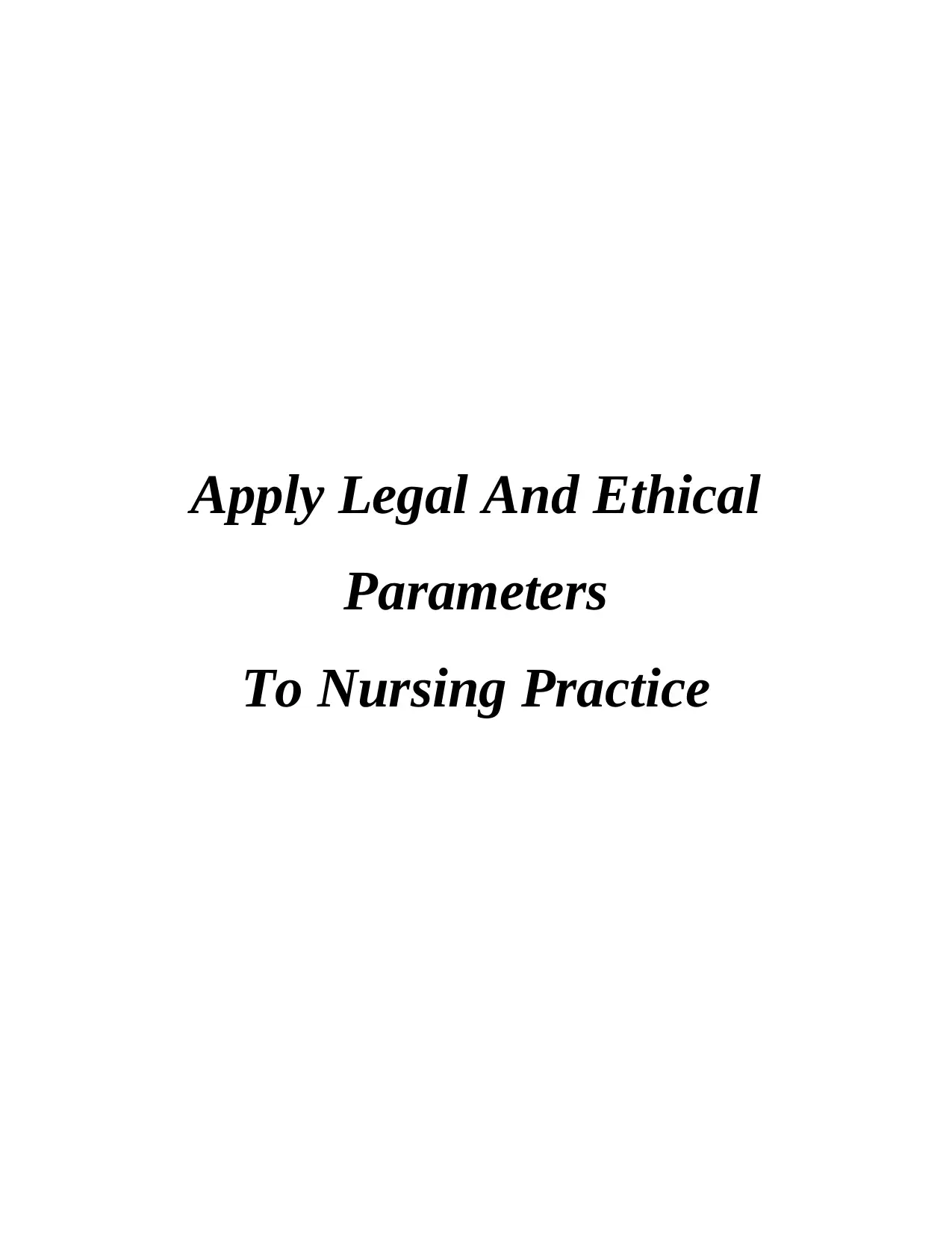
Apply Legal And Ethical
Parameters
To Nursing Practice
Parameters
To Nursing Practice
Paraphrase This Document
Need a fresh take? Get an instant paraphrase of this document with our AI Paraphraser
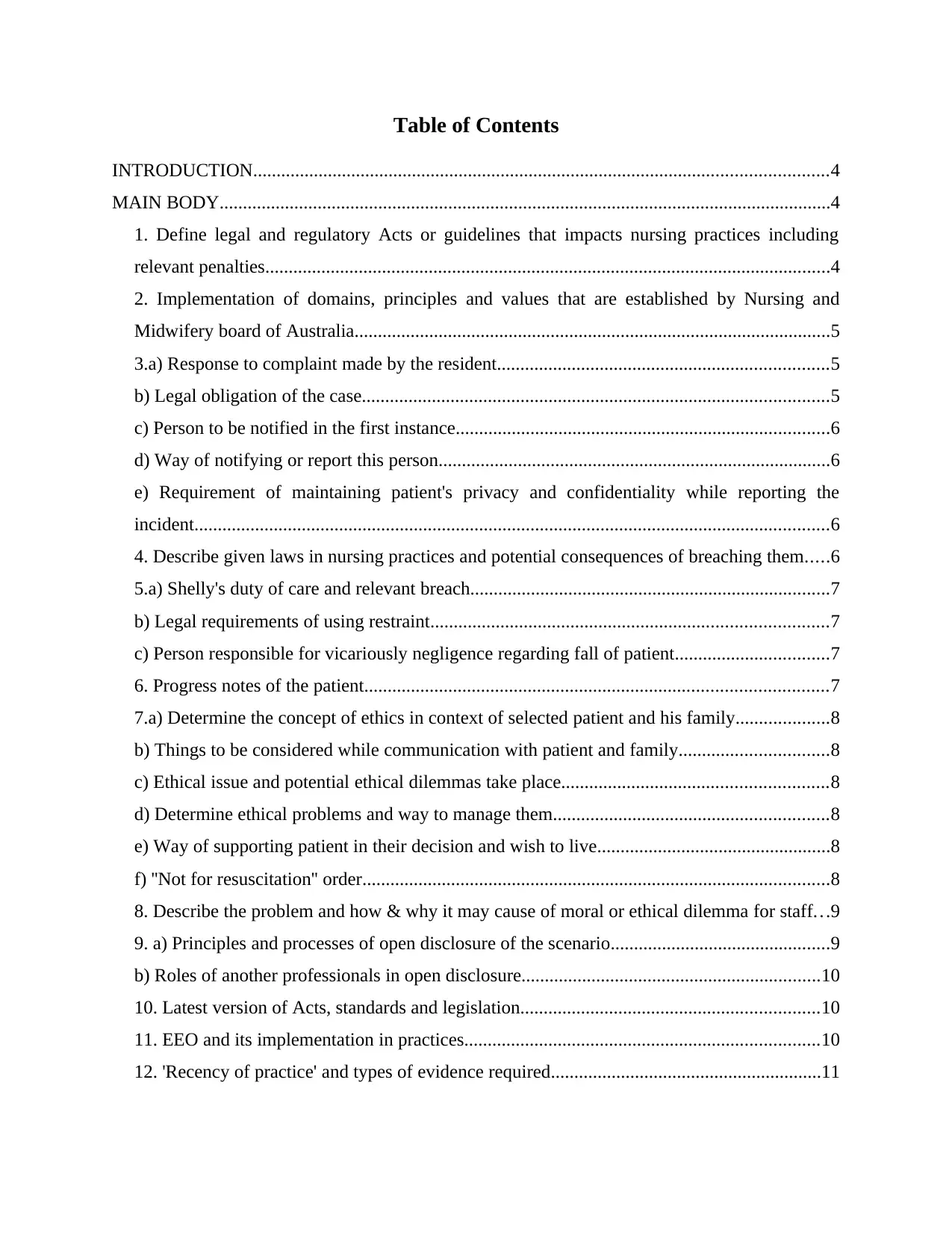
Table of Contents
INTRODUCTION...........................................................................................................................4
MAIN BODY...................................................................................................................................4
1. Define legal and regulatory Acts or guidelines that impacts nursing practices including
relevant penalties.........................................................................................................................4
2. Implementation of domains, principles and values that are established by Nursing and
Midwifery board of Australia......................................................................................................5
3.a) Response to complaint made by the resident.......................................................................5
b) Legal obligation of the case....................................................................................................5
c) Person to be notified in the first instance................................................................................6
d) Way of notifying or report this person....................................................................................6
e) Requirement of maintaining patient's privacy and confidentiality while reporting the
incident........................................................................................................................................6
4. Describe given laws in nursing practices and potential consequences of breaching them.....6
5.a) Shelly's duty of care and relevant breach.............................................................................7
b) Legal requirements of using restraint.....................................................................................7
c) Person responsible for vicariously negligence regarding fall of patient.................................7
6. Progress notes of the patient...................................................................................................7
7.a) Determine the concept of ethics in context of selected patient and his family....................8
b) Things to be considered while communication with patient and family................................8
c) Ethical issue and potential ethical dilemmas take place.........................................................8
d) Determine ethical problems and way to manage them...........................................................8
e) Way of supporting patient in their decision and wish to live..................................................8
f) ''Not for resuscitation'' order....................................................................................................8
8. Describe the problem and how & why it may cause of moral or ethical dilemma for staff...9
9. a) Principles and processes of open disclosure of the scenario...............................................9
b) Roles of another professionals in open disclosure................................................................10
10. Latest version of Acts, standards and legislation................................................................10
11. EEO and its implementation in practices............................................................................10
12. 'Recency of practice' and types of evidence required..........................................................11
INTRODUCTION...........................................................................................................................4
MAIN BODY...................................................................................................................................4
1. Define legal and regulatory Acts or guidelines that impacts nursing practices including
relevant penalties.........................................................................................................................4
2. Implementation of domains, principles and values that are established by Nursing and
Midwifery board of Australia......................................................................................................5
3.a) Response to complaint made by the resident.......................................................................5
b) Legal obligation of the case....................................................................................................5
c) Person to be notified in the first instance................................................................................6
d) Way of notifying or report this person....................................................................................6
e) Requirement of maintaining patient's privacy and confidentiality while reporting the
incident........................................................................................................................................6
4. Describe given laws in nursing practices and potential consequences of breaching them.....6
5.a) Shelly's duty of care and relevant breach.............................................................................7
b) Legal requirements of using restraint.....................................................................................7
c) Person responsible for vicariously negligence regarding fall of patient.................................7
6. Progress notes of the patient...................................................................................................7
7.a) Determine the concept of ethics in context of selected patient and his family....................8
b) Things to be considered while communication with patient and family................................8
c) Ethical issue and potential ethical dilemmas take place.........................................................8
d) Determine ethical problems and way to manage them...........................................................8
e) Way of supporting patient in their decision and wish to live..................................................8
f) ''Not for resuscitation'' order....................................................................................................8
8. Describe the problem and how & why it may cause of moral or ethical dilemma for staff...9
9. a) Principles and processes of open disclosure of the scenario...............................................9
b) Roles of another professionals in open disclosure................................................................10
10. Latest version of Acts, standards and legislation................................................................10
11. EEO and its implementation in practices............................................................................10
12. 'Recency of practice' and types of evidence required..........................................................11
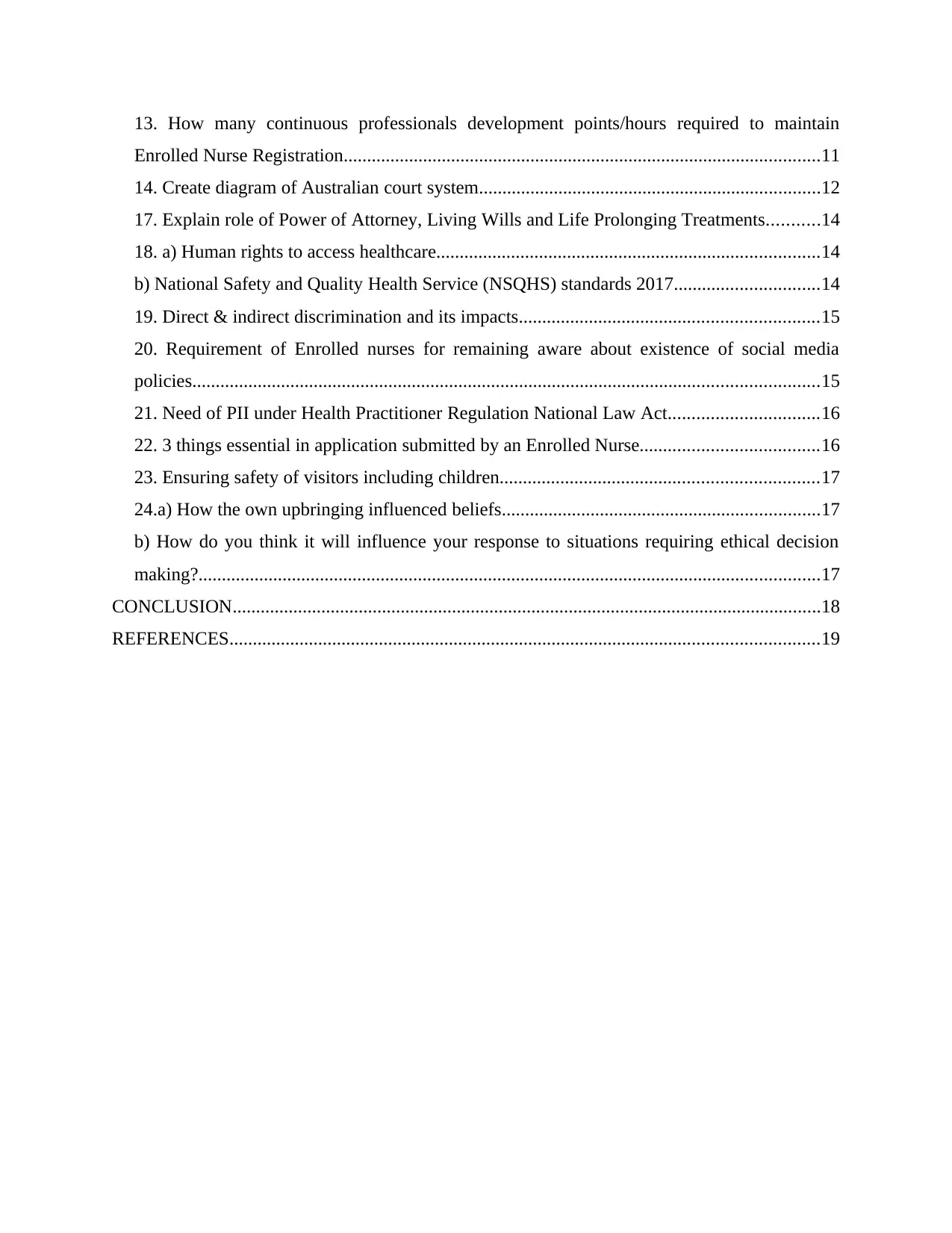
13. How many continuous professionals development points/hours required to maintain
Enrolled Nurse Registration......................................................................................................11
14. Create diagram of Australian court system.........................................................................12
17. Explain role of Power of Attorney, Living Wills and Life Prolonging Treatments...........14
18. a) Human rights to access healthcare..................................................................................14
b) National Safety and Quality Health Service (NSQHS) standards 2017...............................14
19. Direct & indirect discrimination and its impacts................................................................15
20. Requirement of Enrolled nurses for remaining aware about existence of social media
policies......................................................................................................................................15
21. Need of PII under Health Practitioner Regulation National Law Act................................16
22. 3 things essential in application submitted by an Enrolled Nurse......................................16
23. Ensuring safety of visitors including children....................................................................17
24.a) How the own upbringing influenced beliefs....................................................................17
b) How do you think it will influence your response to situations requiring ethical decision
making?.....................................................................................................................................17
CONCLUSION..............................................................................................................................18
REFERENCES..............................................................................................................................19
Enrolled Nurse Registration......................................................................................................11
14. Create diagram of Australian court system.........................................................................12
17. Explain role of Power of Attorney, Living Wills and Life Prolonging Treatments...........14
18. a) Human rights to access healthcare..................................................................................14
b) National Safety and Quality Health Service (NSQHS) standards 2017...............................14
19. Direct & indirect discrimination and its impacts................................................................15
20. Requirement of Enrolled nurses for remaining aware about existence of social media
policies......................................................................................................................................15
21. Need of PII under Health Practitioner Regulation National Law Act................................16
22. 3 things essential in application submitted by an Enrolled Nurse......................................16
23. Ensuring safety of visitors including children....................................................................17
24.a) How the own upbringing influenced beliefs....................................................................17
b) How do you think it will influence your response to situations requiring ethical decision
making?.....................................................................................................................................17
CONCLUSION..............................................................................................................................18
REFERENCES..............................................................................................................................19
⊘ This is a preview!⊘
Do you want full access?
Subscribe today to unlock all pages.

Trusted by 1+ million students worldwide

Paraphrase This Document
Need a fresh take? Get an instant paraphrase of this document with our AI Paraphraser
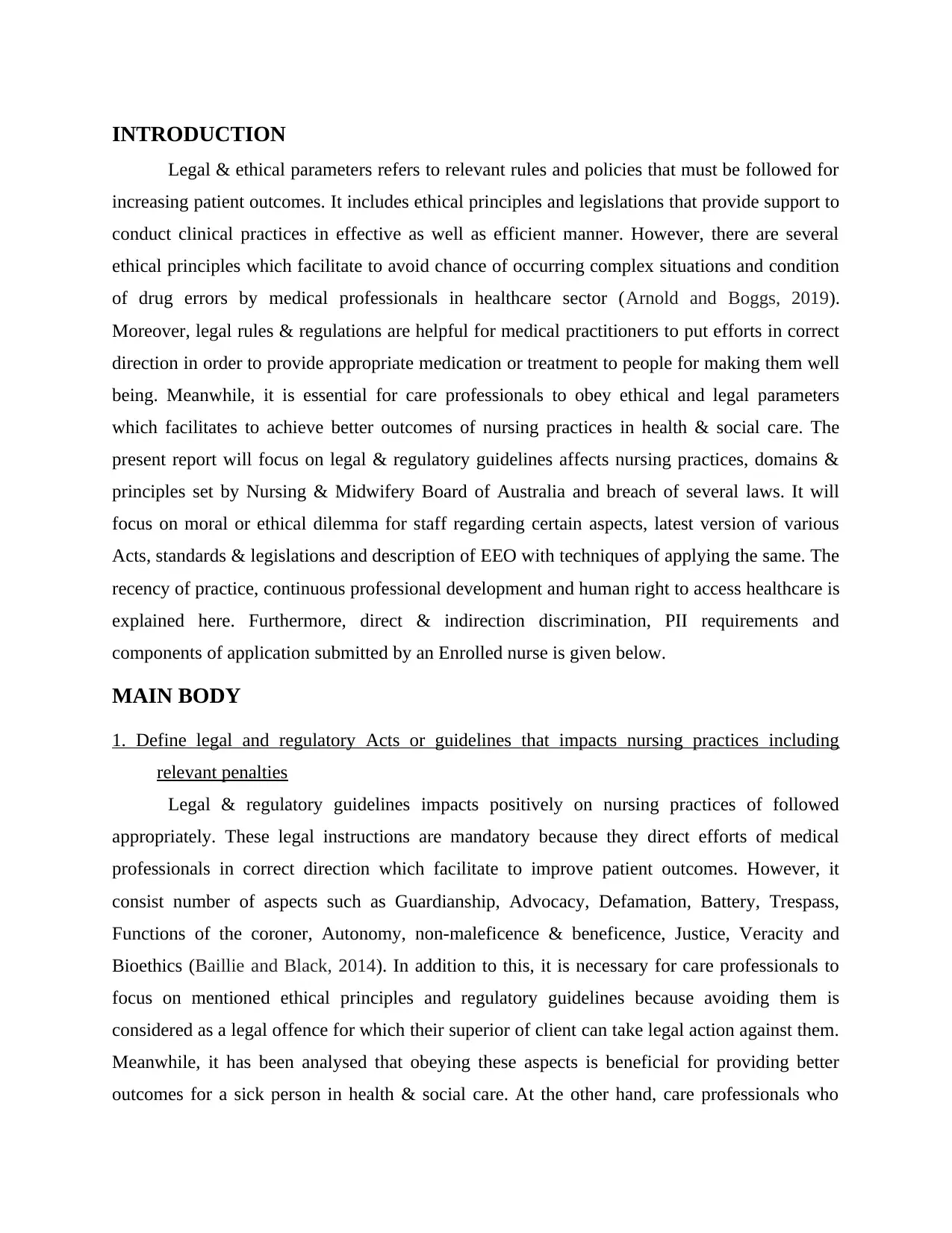
INTRODUCTION
Legal & ethical parameters refers to relevant rules and policies that must be followed for
increasing patient outcomes. It includes ethical principles and legislations that provide support to
conduct clinical practices in effective as well as efficient manner. However, there are several
ethical principles which facilitate to avoid chance of occurring complex situations and condition
of drug errors by medical professionals in healthcare sector (Arnold and Boggs, 2019).
Moreover, legal rules & regulations are helpful for medical practitioners to put efforts in correct
direction in order to provide appropriate medication or treatment to people for making them well
being. Meanwhile, it is essential for care professionals to obey ethical and legal parameters
which facilitates to achieve better outcomes of nursing practices in health & social care. The
present report will focus on legal & regulatory guidelines affects nursing practices, domains &
principles set by Nursing & Midwifery Board of Australia and breach of several laws. It will
focus on moral or ethical dilemma for staff regarding certain aspects, latest version of various
Acts, standards & legislations and description of EEO with techniques of applying the same. The
recency of practice, continuous professional development and human right to access healthcare is
explained here. Furthermore, direct & indirection discrimination, PII requirements and
components of application submitted by an Enrolled nurse is given below.
MAIN BODY
1. Define legal and regulatory Acts or guidelines that impacts nursing practices including
relevant penalties
Legal & regulatory guidelines impacts positively on nursing practices of followed
appropriately. These legal instructions are mandatory because they direct efforts of medical
professionals in correct direction which facilitate to improve patient outcomes. However, it
consist number of aspects such as Guardianship, Advocacy, Defamation, Battery, Trespass,
Functions of the coroner, Autonomy, non-maleficence & beneficence, Justice, Veracity and
Bioethics (Baillie and Black, 2014). In addition to this, it is necessary for care professionals to
focus on mentioned ethical principles and regulatory guidelines because avoiding them is
considered as a legal offence for which their superior of client can take legal action against them.
Meanwhile, it has been analysed that obeying these aspects is beneficial for providing better
outcomes for a sick person in health & social care. At the other hand, care professionals who
Legal & ethical parameters refers to relevant rules and policies that must be followed for
increasing patient outcomes. It includes ethical principles and legislations that provide support to
conduct clinical practices in effective as well as efficient manner. However, there are several
ethical principles which facilitate to avoid chance of occurring complex situations and condition
of drug errors by medical professionals in healthcare sector (Arnold and Boggs, 2019).
Moreover, legal rules & regulations are helpful for medical practitioners to put efforts in correct
direction in order to provide appropriate medication or treatment to people for making them well
being. Meanwhile, it is essential for care professionals to obey ethical and legal parameters
which facilitates to achieve better outcomes of nursing practices in health & social care. The
present report will focus on legal & regulatory guidelines affects nursing practices, domains &
principles set by Nursing & Midwifery Board of Australia and breach of several laws. It will
focus on moral or ethical dilemma for staff regarding certain aspects, latest version of various
Acts, standards & legislations and description of EEO with techniques of applying the same. The
recency of practice, continuous professional development and human right to access healthcare is
explained here. Furthermore, direct & indirection discrimination, PII requirements and
components of application submitted by an Enrolled nurse is given below.
MAIN BODY
1. Define legal and regulatory Acts or guidelines that impacts nursing practices including
relevant penalties
Legal & regulatory guidelines impacts positively on nursing practices of followed
appropriately. These legal instructions are mandatory because they direct efforts of medical
professionals in correct direction which facilitate to improve patient outcomes. However, it
consist number of aspects such as Guardianship, Advocacy, Defamation, Battery, Trespass,
Functions of the coroner, Autonomy, non-maleficence & beneficence, Justice, Veracity and
Bioethics (Baillie and Black, 2014). In addition to this, it is necessary for care professionals to
focus on mentioned ethical principles and regulatory guidelines because avoiding them is
considered as a legal offence for which their superior of client can take legal action against them.
Meanwhile, it has been analysed that obeying these aspects is beneficial for providing better
outcomes for a sick person in health & social care. At the other hand, care professionals who
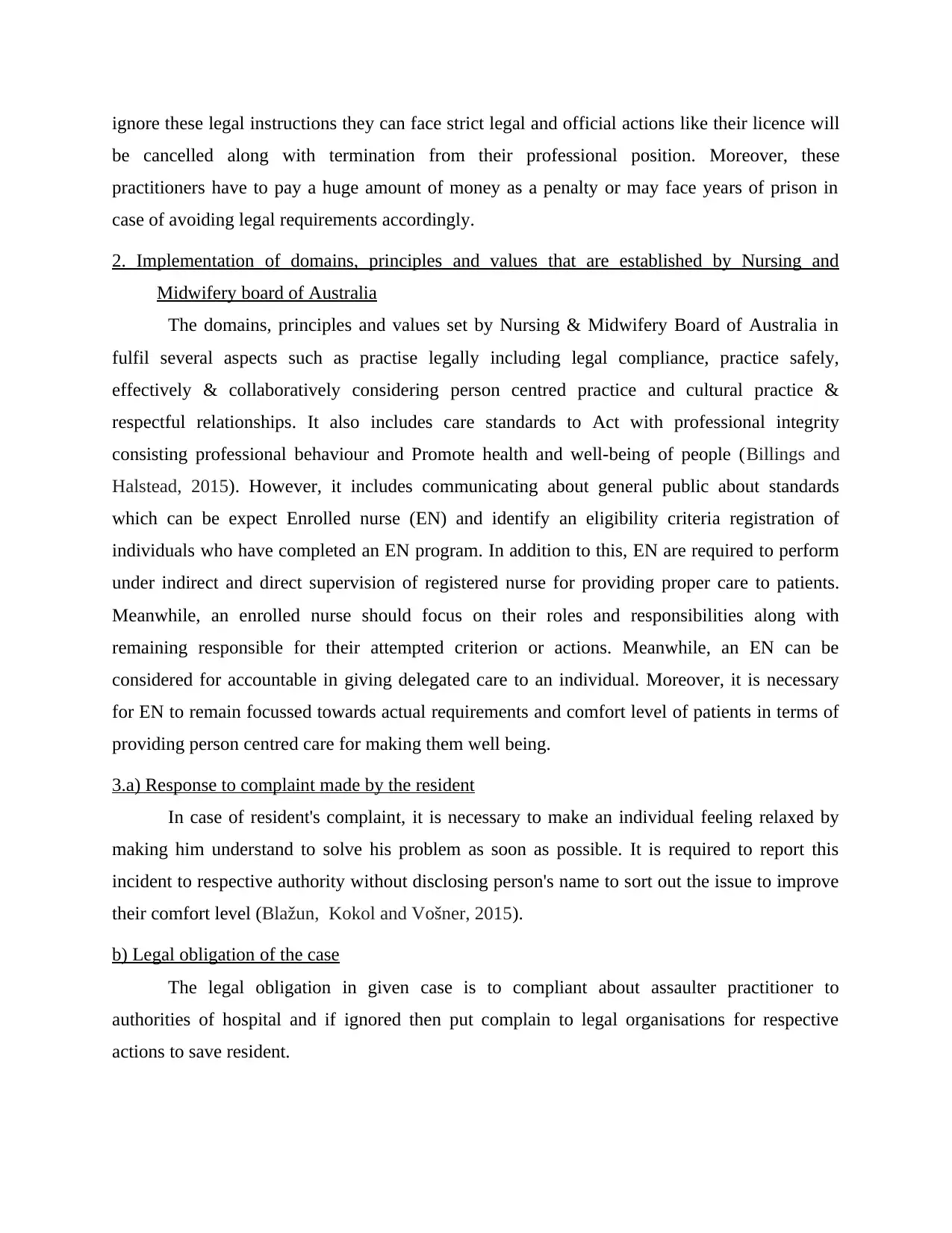
ignore these legal instructions they can face strict legal and official actions like their licence will
be cancelled along with termination from their professional position. Moreover, these
practitioners have to pay a huge amount of money as a penalty or may face years of prison in
case of avoiding legal requirements accordingly.
2. Implementation of domains, principles and values that are established by Nursing and
Midwifery board of Australia
The domains, principles and values set by Nursing & Midwifery Board of Australia in
fulfil several aspects such as practise legally including legal compliance, practice safely,
effectively & collaboratively considering person centred practice and cultural practice &
respectful relationships. It also includes care standards to Act with professional integrity
consisting professional behaviour and Promote health and well-being of people (Billings and
Halstead, 2015). However, it includes communicating about general public about standards
which can be expect Enrolled nurse (EN) and identify an eligibility criteria registration of
individuals who have completed an EN program. In addition to this, EN are required to perform
under indirect and direct supervision of registered nurse for providing proper care to patients.
Meanwhile, an enrolled nurse should focus on their roles and responsibilities along with
remaining responsible for their attempted criterion or actions. Meanwhile, an EN can be
considered for accountable in giving delegated care to an individual. Moreover, it is necessary
for EN to remain focussed towards actual requirements and comfort level of patients in terms of
providing person centred care for making them well being.
3.a) Response to complaint made by the resident
In case of resident's complaint, it is necessary to make an individual feeling relaxed by
making him understand to solve his problem as soon as possible. It is required to report this
incident to respective authority without disclosing person's name to sort out the issue to improve
their comfort level (Blažun, Kokol and Vošner, 2015).
b) Legal obligation of the case
The legal obligation in given case is to compliant about assaulter practitioner to
authorities of hospital and if ignored then put complain to legal organisations for respective
actions to save resident.
be cancelled along with termination from their professional position. Moreover, these
practitioners have to pay a huge amount of money as a penalty or may face years of prison in
case of avoiding legal requirements accordingly.
2. Implementation of domains, principles and values that are established by Nursing and
Midwifery board of Australia
The domains, principles and values set by Nursing & Midwifery Board of Australia in
fulfil several aspects such as practise legally including legal compliance, practice safely,
effectively & collaboratively considering person centred practice and cultural practice &
respectful relationships. It also includes care standards to Act with professional integrity
consisting professional behaviour and Promote health and well-being of people (Billings and
Halstead, 2015). However, it includes communicating about general public about standards
which can be expect Enrolled nurse (EN) and identify an eligibility criteria registration of
individuals who have completed an EN program. In addition to this, EN are required to perform
under indirect and direct supervision of registered nurse for providing proper care to patients.
Meanwhile, an enrolled nurse should focus on their roles and responsibilities along with
remaining responsible for their attempted criterion or actions. Meanwhile, an EN can be
considered for accountable in giving delegated care to an individual. Moreover, it is necessary
for EN to remain focussed towards actual requirements and comfort level of patients in terms of
providing person centred care for making them well being.
3.a) Response to complaint made by the resident
In case of resident's complaint, it is necessary to make an individual feeling relaxed by
making him understand to solve his problem as soon as possible. It is required to report this
incident to respective authority without disclosing person's name to sort out the issue to improve
their comfort level (Blažun, Kokol and Vošner, 2015).
b) Legal obligation of the case
The legal obligation in given case is to compliant about assaulter practitioner to
authorities of hospital and if ignored then put complain to legal organisations for respective
actions to save resident.
⊘ This is a preview!⊘
Do you want full access?
Subscribe today to unlock all pages.

Trusted by 1+ million students worldwide
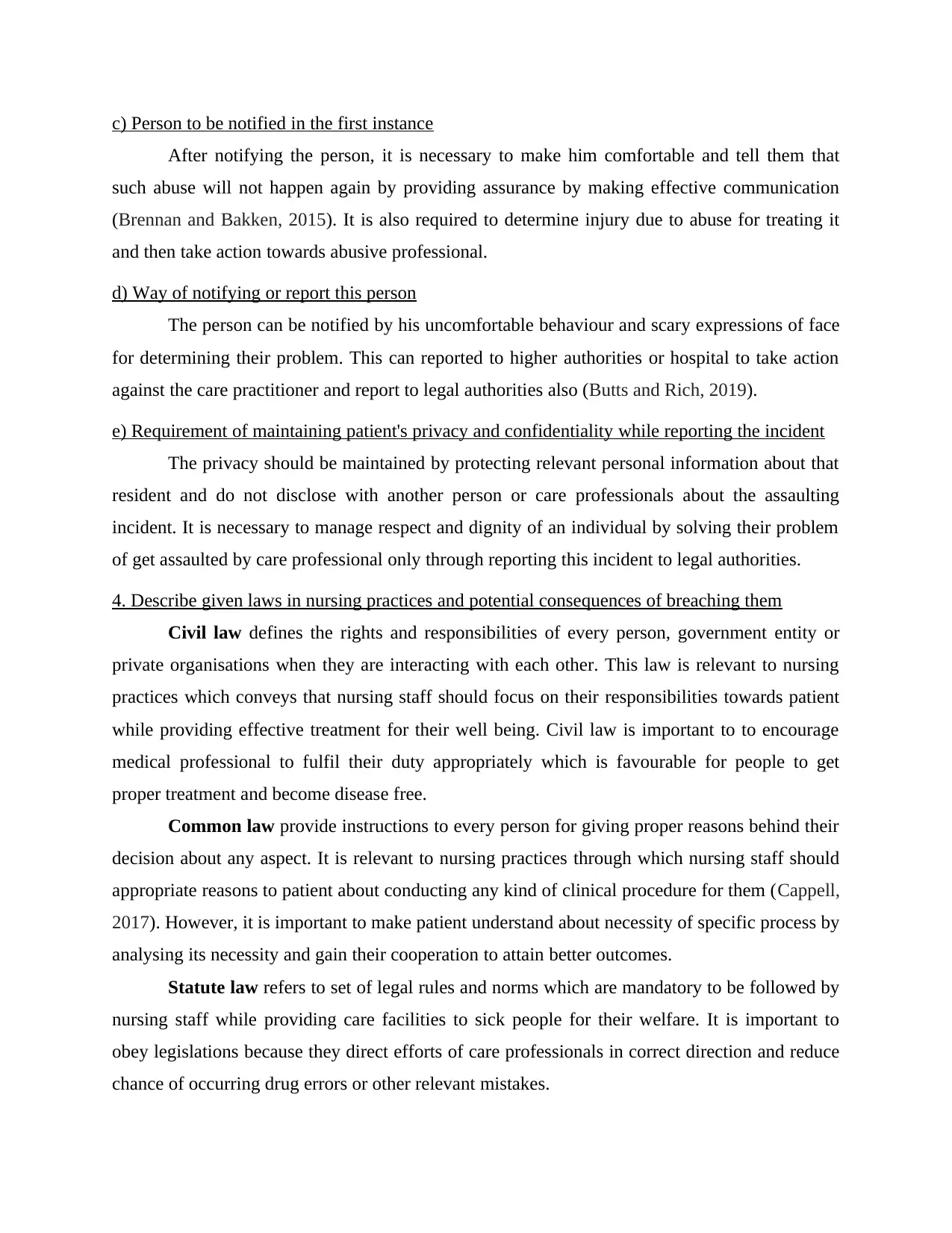
c) Person to be notified in the first instance
After notifying the person, it is necessary to make him comfortable and tell them that
such abuse will not happen again by providing assurance by making effective communication
(Brennan and Bakken, 2015). It is also required to determine injury due to abuse for treating it
and then take action towards abusive professional.
d) Way of notifying or report this person
The person can be notified by his uncomfortable behaviour and scary expressions of face
for determining their problem. This can reported to higher authorities or hospital to take action
against the care practitioner and report to legal authorities also (Butts and Rich, 2019).
e) Requirement of maintaining patient's privacy and confidentiality while reporting the incident
The privacy should be maintained by protecting relevant personal information about that
resident and do not disclose with another person or care professionals about the assaulting
incident. It is necessary to manage respect and dignity of an individual by solving their problem
of get assaulted by care professional only through reporting this incident to legal authorities.
4. Describe given laws in nursing practices and potential consequences of breaching them
Civil law defines the rights and responsibilities of every person, government entity or
private organisations when they are interacting with each other. This law is relevant to nursing
practices which conveys that nursing staff should focus on their responsibilities towards patient
while providing effective treatment for their well being. Civil law is important to to encourage
medical professional to fulfil their duty appropriately which is favourable for people to get
proper treatment and become disease free.
Common law provide instructions to every person for giving proper reasons behind their
decision about any aspect. It is relevant to nursing practices through which nursing staff should
appropriate reasons to patient about conducting any kind of clinical procedure for them (Cappell,
2017). However, it is important to make patient understand about necessity of specific process by
analysing its necessity and gain their cooperation to attain better outcomes.
Statute law refers to set of legal rules and norms which are mandatory to be followed by
nursing staff while providing care facilities to sick people for their welfare. It is important to
obey legislations because they direct efforts of care professionals in correct direction and reduce
chance of occurring drug errors or other relevant mistakes.
After notifying the person, it is necessary to make him comfortable and tell them that
such abuse will not happen again by providing assurance by making effective communication
(Brennan and Bakken, 2015). It is also required to determine injury due to abuse for treating it
and then take action towards abusive professional.
d) Way of notifying or report this person
The person can be notified by his uncomfortable behaviour and scary expressions of face
for determining their problem. This can reported to higher authorities or hospital to take action
against the care practitioner and report to legal authorities also (Butts and Rich, 2019).
e) Requirement of maintaining patient's privacy and confidentiality while reporting the incident
The privacy should be maintained by protecting relevant personal information about that
resident and do not disclose with another person or care professionals about the assaulting
incident. It is necessary to manage respect and dignity of an individual by solving their problem
of get assaulted by care professional only through reporting this incident to legal authorities.
4. Describe given laws in nursing practices and potential consequences of breaching them
Civil law defines the rights and responsibilities of every person, government entity or
private organisations when they are interacting with each other. This law is relevant to nursing
practices which conveys that nursing staff should focus on their responsibilities towards patient
while providing effective treatment for their well being. Civil law is important to to encourage
medical professional to fulfil their duty appropriately which is favourable for people to get
proper treatment and become disease free.
Common law provide instructions to every person for giving proper reasons behind their
decision about any aspect. It is relevant to nursing practices through which nursing staff should
appropriate reasons to patient about conducting any kind of clinical procedure for them (Cappell,
2017). However, it is important to make patient understand about necessity of specific process by
analysing its necessity and gain their cooperation to attain better outcomes.
Statute law refers to set of legal rules and norms which are mandatory to be followed by
nursing staff while providing care facilities to sick people for their welfare. It is important to
obey legislations because they direct efforts of care professionals in correct direction and reduce
chance of occurring drug errors or other relevant mistakes.
Paraphrase This Document
Need a fresh take? Get an instant paraphrase of this document with our AI Paraphraser
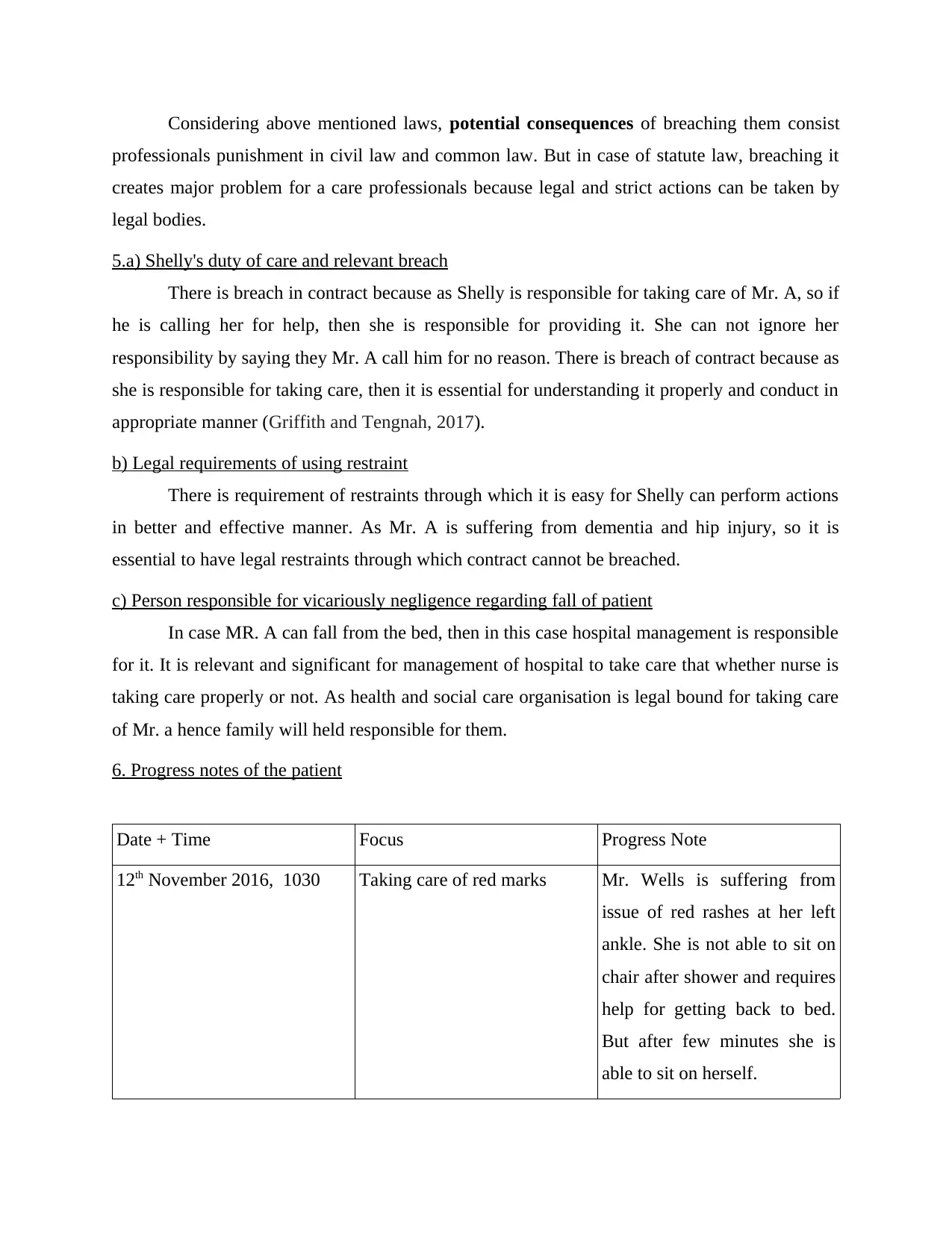
Considering above mentioned laws, potential consequences of breaching them consist
professionals punishment in civil law and common law. But in case of statute law, breaching it
creates major problem for a care professionals because legal and strict actions can be taken by
legal bodies.
5.a) Shelly's duty of care and relevant breach
There is breach in contract because as Shelly is responsible for taking care of Mr. A, so if
he is calling her for help, then she is responsible for providing it. She can not ignore her
responsibility by saying they Mr. A call him for no reason. There is breach of contract because as
she is responsible for taking care, then it is essential for understanding it properly and conduct in
appropriate manner (Griffith and Tengnah, 2017).
b) Legal requirements of using restraint
There is requirement of restraints through which it is easy for Shelly can perform actions
in better and effective manner. As Mr. A is suffering from dementia and hip injury, so it is
essential to have legal restraints through which contract cannot be breached.
c) Person responsible for vicariously negligence regarding fall of patient
In case MR. A can fall from the bed, then in this case hospital management is responsible
for it. It is relevant and significant for management of hospital to take care that whether nurse is
taking care properly or not. As health and social care organisation is legal bound for taking care
of Mr. a hence family will held responsible for them.
6. Progress notes of the patient
Date + Time Focus Progress Note
12th November 2016, 1030 Taking care of red marks Mr. Wells is suffering from
issue of red rashes at her left
ankle. She is not able to sit on
chair after shower and requires
help for getting back to bed.
But after few minutes she is
able to sit on herself.
professionals punishment in civil law and common law. But in case of statute law, breaching it
creates major problem for a care professionals because legal and strict actions can be taken by
legal bodies.
5.a) Shelly's duty of care and relevant breach
There is breach in contract because as Shelly is responsible for taking care of Mr. A, so if
he is calling her for help, then she is responsible for providing it. She can not ignore her
responsibility by saying they Mr. A call him for no reason. There is breach of contract because as
she is responsible for taking care, then it is essential for understanding it properly and conduct in
appropriate manner (Griffith and Tengnah, 2017).
b) Legal requirements of using restraint
There is requirement of restraints through which it is easy for Shelly can perform actions
in better and effective manner. As Mr. A is suffering from dementia and hip injury, so it is
essential to have legal restraints through which contract cannot be breached.
c) Person responsible for vicariously negligence regarding fall of patient
In case MR. A can fall from the bed, then in this case hospital management is responsible
for it. It is relevant and significant for management of hospital to take care that whether nurse is
taking care properly or not. As health and social care organisation is legal bound for taking care
of Mr. a hence family will held responsible for them.
6. Progress notes of the patient
Date + Time Focus Progress Note
12th November 2016, 1030 Taking care of red marks Mr. Wells is suffering from
issue of red rashes at her left
ankle. She is not able to sit on
chair after shower and requires
help for getting back to bed.
But after few minutes she is
able to sit on herself.
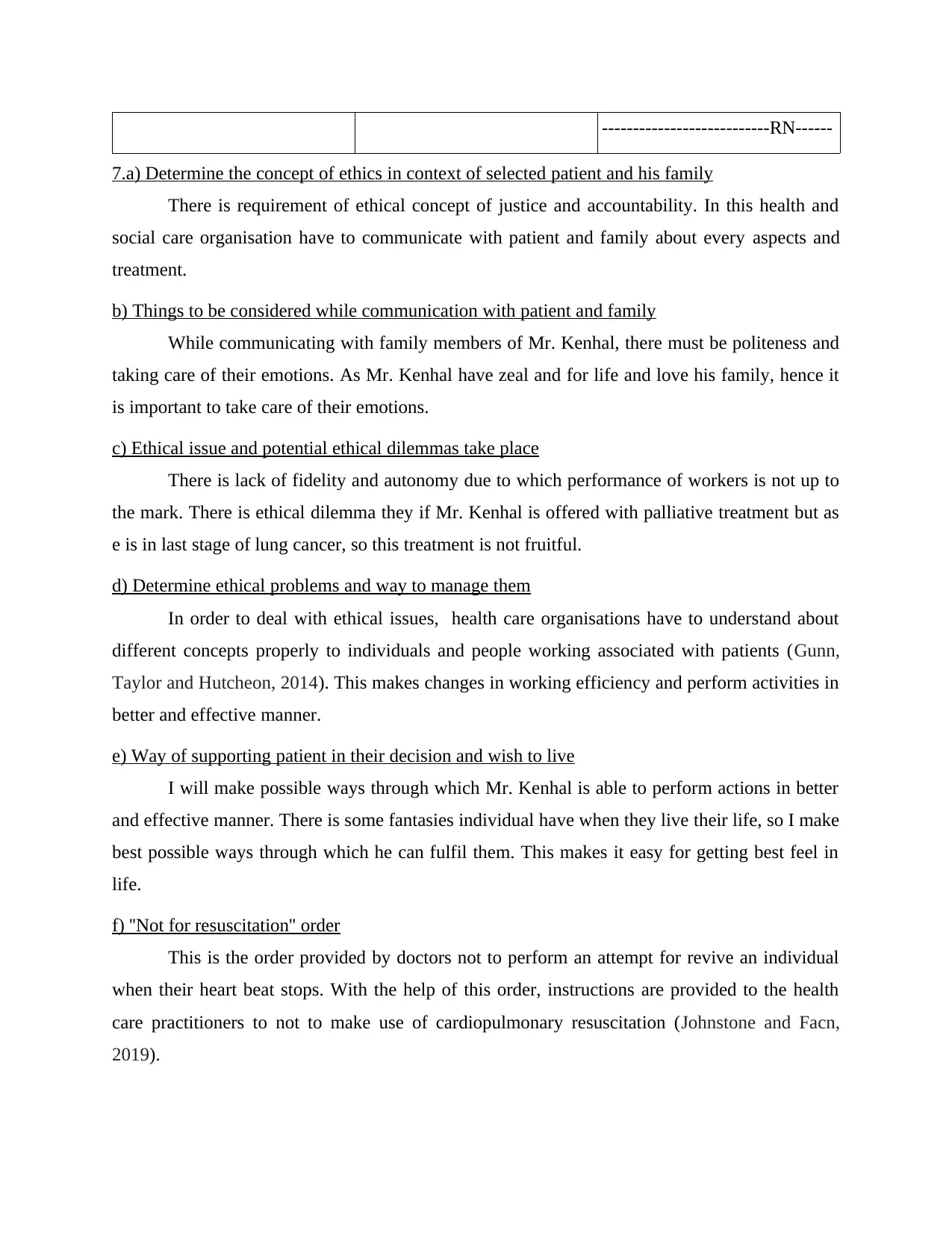
---------------------------RN------
7.a) Determine the concept of ethics in context of selected patient and his family
There is requirement of ethical concept of justice and accountability. In this health and
social care organisation have to communicate with patient and family about every aspects and
treatment.
b) Things to be considered while communication with patient and family
While communicating with family members of Mr. Kenhal, there must be politeness and
taking care of their emotions. As Mr. Kenhal have zeal and for life and love his family, hence it
is important to take care of their emotions.
c) Ethical issue and potential ethical dilemmas take place
There is lack of fidelity and autonomy due to which performance of workers is not up to
the mark. There is ethical dilemma they if Mr. Kenhal is offered with palliative treatment but as
e is in last stage of lung cancer, so this treatment is not fruitful.
d) Determine ethical problems and way to manage them
In order to deal with ethical issues, health care organisations have to understand about
different concepts properly to individuals and people working associated with patients (Gunn,
Taylor and Hutcheon, 2014). This makes changes in working efficiency and perform activities in
better and effective manner.
e) Way of supporting patient in their decision and wish to live
I will make possible ways through which Mr. Kenhal is able to perform actions in better
and effective manner. There is some fantasies individual have when they live their life, so I make
best possible ways through which he can fulfil them. This makes it easy for getting best feel in
life.
f) ''Not for resuscitation'' order
This is the order provided by doctors not to perform an attempt for revive an individual
when their heart beat stops. With the help of this order, instructions are provided to the health
care practitioners to not to make use of cardiopulmonary resuscitation (Johnstone and Facn,
2019).
7.a) Determine the concept of ethics in context of selected patient and his family
There is requirement of ethical concept of justice and accountability. In this health and
social care organisation have to communicate with patient and family about every aspects and
treatment.
b) Things to be considered while communication with patient and family
While communicating with family members of Mr. Kenhal, there must be politeness and
taking care of their emotions. As Mr. Kenhal have zeal and for life and love his family, hence it
is important to take care of their emotions.
c) Ethical issue and potential ethical dilemmas take place
There is lack of fidelity and autonomy due to which performance of workers is not up to
the mark. There is ethical dilemma they if Mr. Kenhal is offered with palliative treatment but as
e is in last stage of lung cancer, so this treatment is not fruitful.
d) Determine ethical problems and way to manage them
In order to deal with ethical issues, health care organisations have to understand about
different concepts properly to individuals and people working associated with patients (Gunn,
Taylor and Hutcheon, 2014). This makes changes in working efficiency and perform activities in
better and effective manner.
e) Way of supporting patient in their decision and wish to live
I will make possible ways through which Mr. Kenhal is able to perform actions in better
and effective manner. There is some fantasies individual have when they live their life, so I make
best possible ways through which he can fulfil them. This makes it easy for getting best feel in
life.
f) ''Not for resuscitation'' order
This is the order provided by doctors not to perform an attempt for revive an individual
when their heart beat stops. With the help of this order, instructions are provided to the health
care practitioners to not to make use of cardiopulmonary resuscitation (Johnstone and Facn,
2019).
⊘ This is a preview!⊘
Do you want full access?
Subscribe today to unlock all pages.

Trusted by 1+ million students worldwide
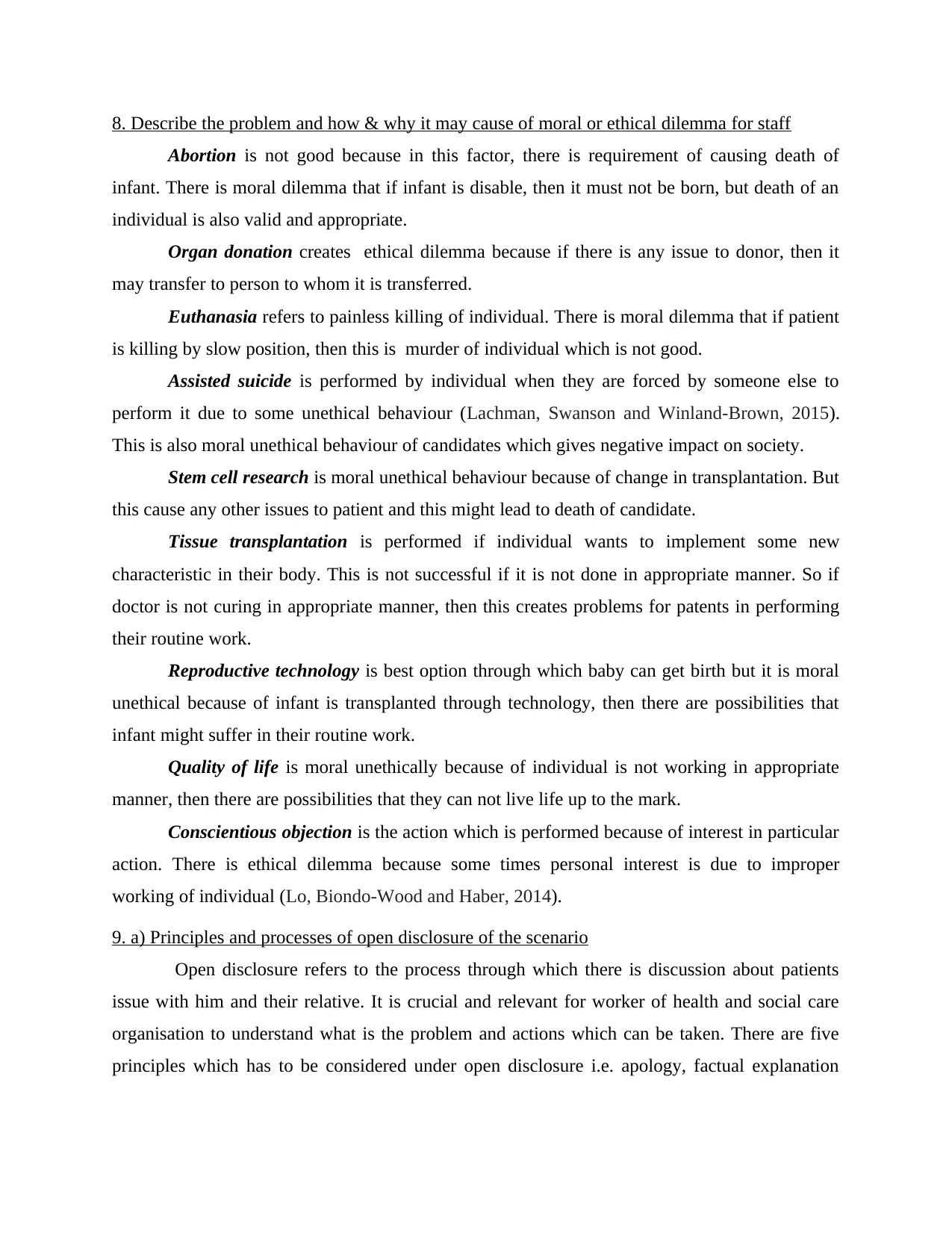
8. Describe the problem and how & why it may cause of moral or ethical dilemma for staff
Abortion is not good because in this factor, there is requirement of causing death of
infant. There is moral dilemma that if infant is disable, then it must not be born, but death of an
individual is also valid and appropriate.
Organ donation creates ethical dilemma because if there is any issue to donor, then it
may transfer to person to whom it is transferred.
Euthanasia refers to painless killing of individual. There is moral dilemma that if patient
is killing by slow position, then this is murder of individual which is not good.
Assisted suicide is performed by individual when they are forced by someone else to
perform it due to some unethical behaviour (Lachman, Swanson and Winland-Brown, 2015).
This is also moral unethical behaviour of candidates which gives negative impact on society.
Stem cell research is moral unethical behaviour because of change in transplantation. But
this cause any other issues to patient and this might lead to death of candidate.
Tissue transplantation is performed if individual wants to implement some new
characteristic in their body. This is not successful if it is not done in appropriate manner. So if
doctor is not curing in appropriate manner, then this creates problems for patents in performing
their routine work.
Reproductive technology is best option through which baby can get birth but it is moral
unethical because of infant is transplanted through technology, then there are possibilities that
infant might suffer in their routine work.
Quality of life is moral unethically because of individual is not working in appropriate
manner, then there are possibilities that they can not live life up to the mark.
Conscientious objection is the action which is performed because of interest in particular
action. There is ethical dilemma because some times personal interest is due to improper
working of individual (Lo, Biondo-Wood and Haber, 2014).
9. a) Principles and processes of open disclosure of the scenario
Open disclosure refers to the process through which there is discussion about patients
issue with him and their relative. It is crucial and relevant for worker of health and social care
organisation to understand what is the problem and actions which can be taken. There are five
principles which has to be considered under open disclosure i.e. apology, factual explanation
Abortion is not good because in this factor, there is requirement of causing death of
infant. There is moral dilemma that if infant is disable, then it must not be born, but death of an
individual is also valid and appropriate.
Organ donation creates ethical dilemma because if there is any issue to donor, then it
may transfer to person to whom it is transferred.
Euthanasia refers to painless killing of individual. There is moral dilemma that if patient
is killing by slow position, then this is murder of individual which is not good.
Assisted suicide is performed by individual when they are forced by someone else to
perform it due to some unethical behaviour (Lachman, Swanson and Winland-Brown, 2015).
This is also moral unethical behaviour of candidates which gives negative impact on society.
Stem cell research is moral unethical behaviour because of change in transplantation. But
this cause any other issues to patient and this might lead to death of candidate.
Tissue transplantation is performed if individual wants to implement some new
characteristic in their body. This is not successful if it is not done in appropriate manner. So if
doctor is not curing in appropriate manner, then this creates problems for patents in performing
their routine work.
Reproductive technology is best option through which baby can get birth but it is moral
unethical because of infant is transplanted through technology, then there are possibilities that
infant might suffer in their routine work.
Quality of life is moral unethically because of individual is not working in appropriate
manner, then there are possibilities that they can not live life up to the mark.
Conscientious objection is the action which is performed because of interest in particular
action. There is ethical dilemma because some times personal interest is due to improper
working of individual (Lo, Biondo-Wood and Haber, 2014).
9. a) Principles and processes of open disclosure of the scenario
Open disclosure refers to the process through which there is discussion about patients
issue with him and their relative. It is crucial and relevant for worker of health and social care
organisation to understand what is the problem and actions which can be taken. There are five
principles which has to be considered under open disclosure i.e. apology, factual explanation
Paraphrase This Document
Need a fresh take? Get an instant paraphrase of this document with our AI Paraphraser
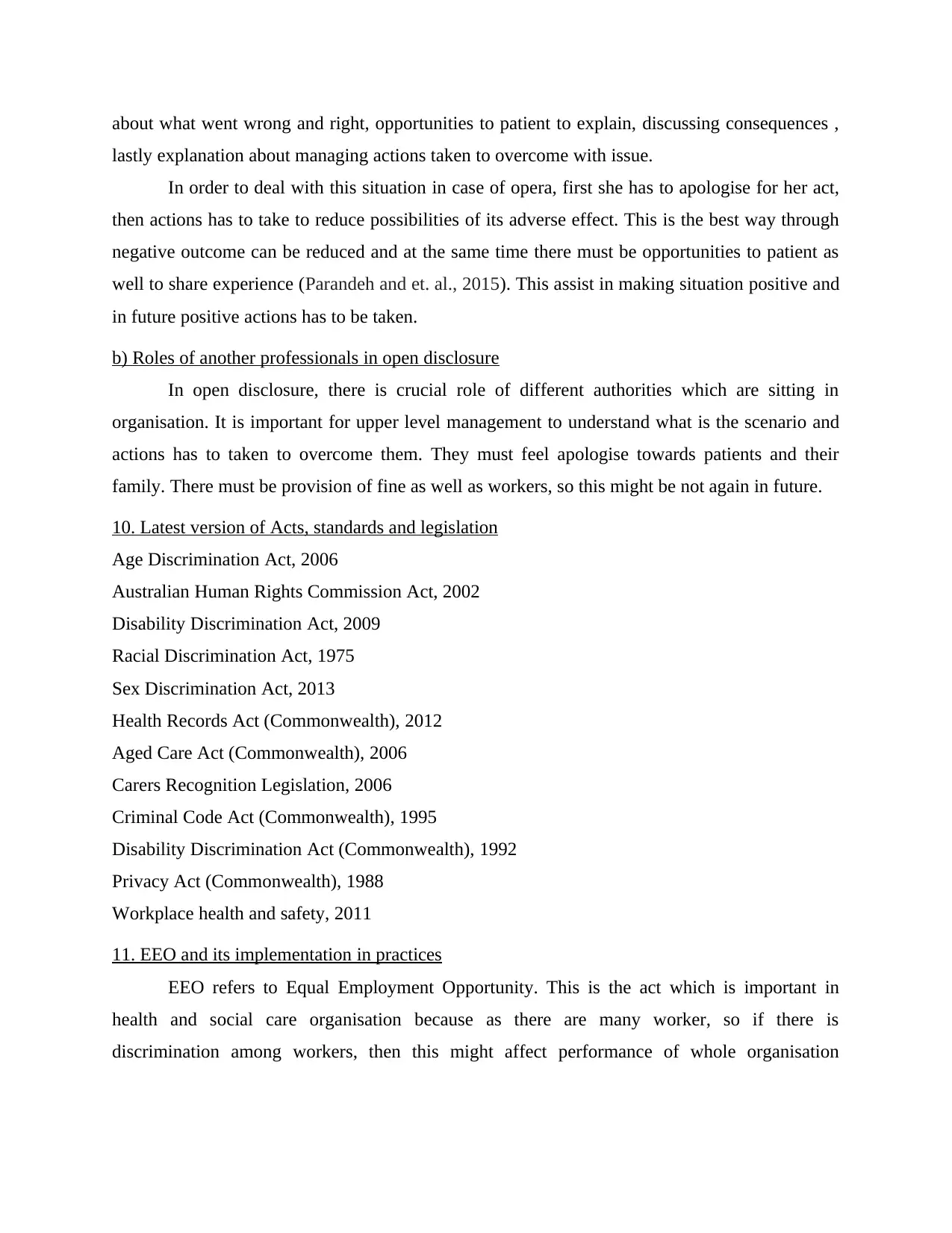
about what went wrong and right, opportunities to patient to explain, discussing consequences ,
lastly explanation about managing actions taken to overcome with issue.
In order to deal with this situation in case of opera, first she has to apologise for her act,
then actions has to take to reduce possibilities of its adverse effect. This is the best way through
negative outcome can be reduced and at the same time there must be opportunities to patient as
well to share experience (Parandeh and et. al., 2015). This assist in making situation positive and
in future positive actions has to be taken.
b) Roles of another professionals in open disclosure
In open disclosure, there is crucial role of different authorities which are sitting in
organisation. It is important for upper level management to understand what is the scenario and
actions has to taken to overcome them. They must feel apologise towards patients and their
family. There must be provision of fine as well as workers, so this might be not again in future.
10. Latest version of Acts, standards and legislation
Age Discrimination Act, 2006
Australian Human Rights Commission Act, 2002
Disability Discrimination Act, 2009
Racial Discrimination Act, 1975
Sex Discrimination Act, 2013
Health Records Act (Commonwealth), 2012
Aged Care Act (Commonwealth), 2006
Carers Recognition Legislation, 2006
Criminal Code Act (Commonwealth), 1995
Disability Discrimination Act (Commonwealth), 1992
Privacy Act (Commonwealth), 1988
Workplace health and safety, 2011
11. EEO and its implementation in practices
EEO refers to Equal Employment Opportunity. This is the act which is important in
health and social care organisation because as there are many worker, so if there is
discrimination among workers, then this might affect performance of whole organisation
lastly explanation about managing actions taken to overcome with issue.
In order to deal with this situation in case of opera, first she has to apologise for her act,
then actions has to take to reduce possibilities of its adverse effect. This is the best way through
negative outcome can be reduced and at the same time there must be opportunities to patient as
well to share experience (Parandeh and et. al., 2015). This assist in making situation positive and
in future positive actions has to be taken.
b) Roles of another professionals in open disclosure
In open disclosure, there is crucial role of different authorities which are sitting in
organisation. It is important for upper level management to understand what is the scenario and
actions has to taken to overcome them. They must feel apologise towards patients and their
family. There must be provision of fine as well as workers, so this might be not again in future.
10. Latest version of Acts, standards and legislation
Age Discrimination Act, 2006
Australian Human Rights Commission Act, 2002
Disability Discrimination Act, 2009
Racial Discrimination Act, 1975
Sex Discrimination Act, 2013
Health Records Act (Commonwealth), 2012
Aged Care Act (Commonwealth), 2006
Carers Recognition Legislation, 2006
Criminal Code Act (Commonwealth), 1995
Disability Discrimination Act (Commonwealth), 1992
Privacy Act (Commonwealth), 1988
Workplace health and safety, 2011
11. EEO and its implementation in practices
EEO refers to Equal Employment Opportunity. This is the act which is important in
health and social care organisation because as there are many worker, so if there is
discrimination among workers, then this might affect performance of whole organisation
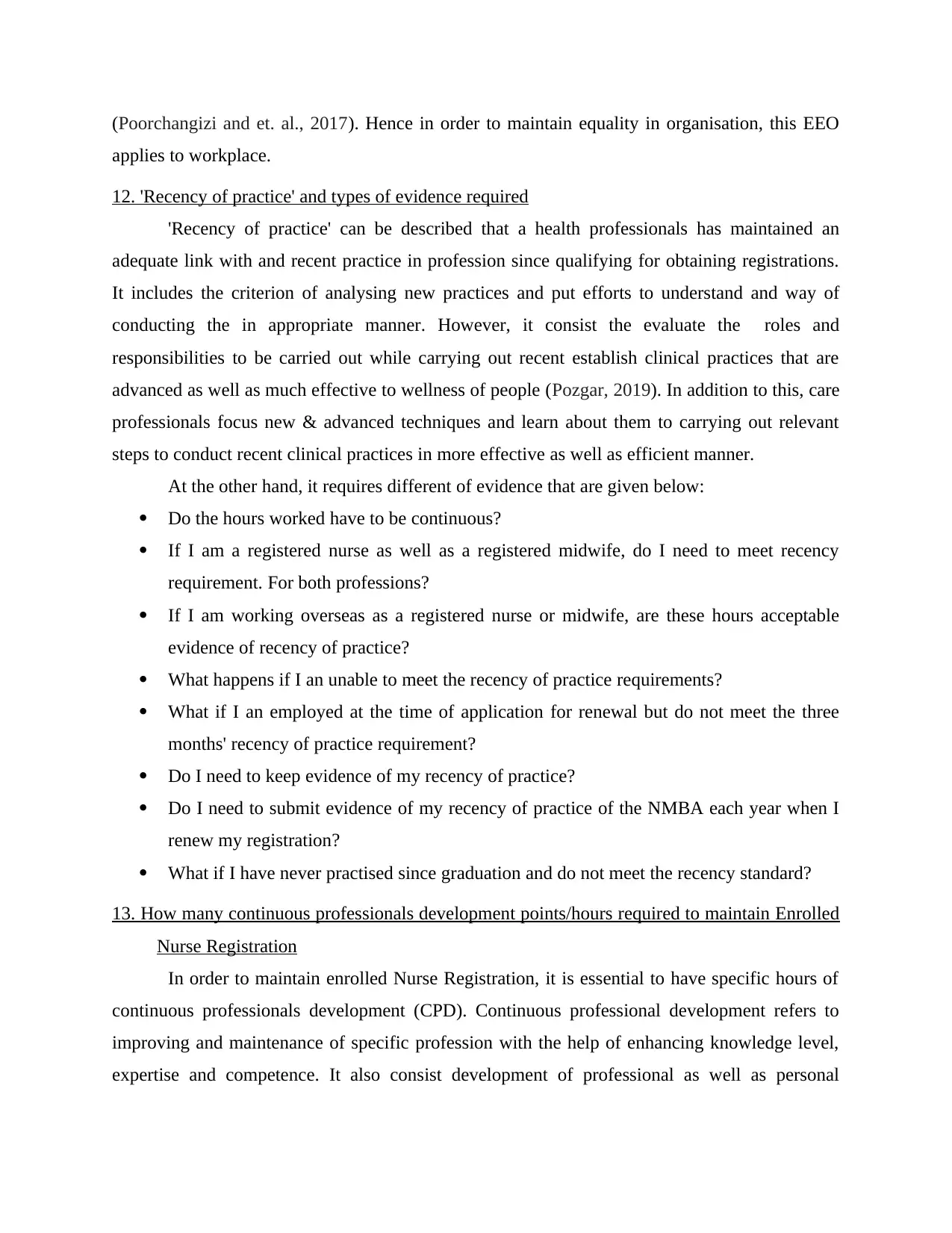
(Poorchangizi and et. al., 2017). Hence in order to maintain equality in organisation, this EEO
applies to workplace.
12. 'Recency of practice' and types of evidence required
'Recency of practice' can be described that a health professionals has maintained an
adequate link with and recent practice in profession since qualifying for obtaining registrations.
It includes the criterion of analysing new practices and put efforts to understand and way of
conducting the in appropriate manner. However, it consist the evaluate the roles and
responsibilities to be carried out while carrying out recent establish clinical practices that are
advanced as well as much effective to wellness of people (Pozgar, 2019). In addition to this, care
professionals focus new & advanced techniques and learn about them to carrying out relevant
steps to conduct recent clinical practices in more effective as well as efficient manner.
At the other hand, it requires different of evidence that are given below:
Do the hours worked have to be continuous?
If I am a registered nurse as well as a registered midwife, do I need to meet recency
requirement. For both professions?
If I am working overseas as a registered nurse or midwife, are these hours acceptable
evidence of recency of practice?
What happens if I an unable to meet the recency of practice requirements?
What if I an employed at the time of application for renewal but do not meet the three
months' recency of practice requirement?
Do I need to keep evidence of my recency of practice?
Do I need to submit evidence of my recency of practice of the NMBA each year when I
renew my registration?
What if I have never practised since graduation and do not meet the recency standard?
13. How many continuous professionals development points/hours required to maintain Enrolled
Nurse Registration
In order to maintain enrolled Nurse Registration, it is essential to have specific hours of
continuous professionals development (CPD). Continuous professional development refers to
improving and maintenance of specific profession with the help of enhancing knowledge level,
expertise and competence. It also consist development of professional as well as personal
applies to workplace.
12. 'Recency of practice' and types of evidence required
'Recency of practice' can be described that a health professionals has maintained an
adequate link with and recent practice in profession since qualifying for obtaining registrations.
It includes the criterion of analysing new practices and put efforts to understand and way of
conducting the in appropriate manner. However, it consist the evaluate the roles and
responsibilities to be carried out while carrying out recent establish clinical practices that are
advanced as well as much effective to wellness of people (Pozgar, 2019). In addition to this, care
professionals focus new & advanced techniques and learn about them to carrying out relevant
steps to conduct recent clinical practices in more effective as well as efficient manner.
At the other hand, it requires different of evidence that are given below:
Do the hours worked have to be continuous?
If I am a registered nurse as well as a registered midwife, do I need to meet recency
requirement. For both professions?
If I am working overseas as a registered nurse or midwife, are these hours acceptable
evidence of recency of practice?
What happens if I an unable to meet the recency of practice requirements?
What if I an employed at the time of application for renewal but do not meet the three
months' recency of practice requirement?
Do I need to keep evidence of my recency of practice?
Do I need to submit evidence of my recency of practice of the NMBA each year when I
renew my registration?
What if I have never practised since graduation and do not meet the recency standard?
13. How many continuous professionals development points/hours required to maintain Enrolled
Nurse Registration
In order to maintain enrolled Nurse Registration, it is essential to have specific hours of
continuous professionals development (CPD). Continuous professional development refers to
improving and maintenance of specific profession with the help of enhancing knowledge level,
expertise and competence. It also consist development of professional as well as personal
⊘ This is a preview!⊘
Do you want full access?
Subscribe today to unlock all pages.

Trusted by 1+ million students worldwide
1 out of 21
Related Documents
Your All-in-One AI-Powered Toolkit for Academic Success.
+13062052269
info@desklib.com
Available 24*7 on WhatsApp / Email
![[object Object]](/_next/static/media/star-bottom.7253800d.svg)
Unlock your academic potential
Copyright © 2020–2025 A2Z Services. All Rights Reserved. Developed and managed by ZUCOL.





